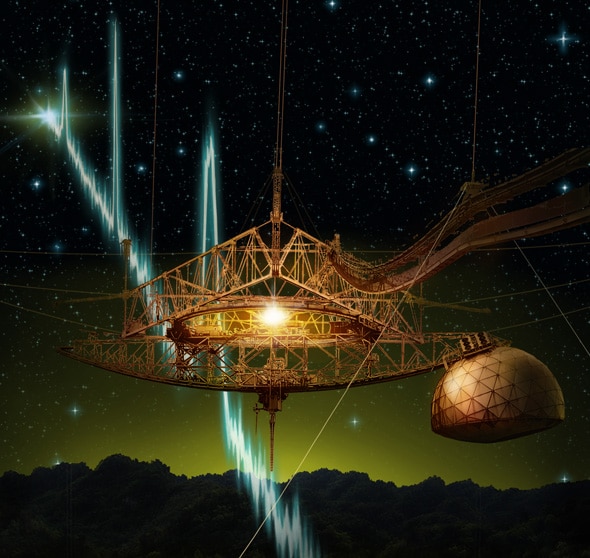Create a free profile to get unlimited access to exclusive videos, sweepstakes, and more!
FRB Update Part 2: Repeating Fast Radio Burst Opens Up the Playing Field

When I first wrote about fast radio bursts (FRBs—and please read the follow-up on that)—sudden cosmic blasts of radio waves that come and go in milliseconds—I mentioned that lots of different unrelated phenomena can probably produce them. Radio waves are generated by planets, stars, gas clouds, black holes, and a host of other astronomical objects, so there’s no reason to limit ourselves when we think of what their source might be.
Not only that, but gamma-ray bursts, the second most energetic bangs in the Universe since the Big one, are similar in nature, but also come from a variety of different objects. Again, the Universe is telling us to be open-minded.
And now that looks like it’s the case! A fast radio burst detected in 2012 has now been seen to repeat.
That’s big news. Every other FRB detected has been a one-off kind of thing: Now you see it, now you don’t. But FRB 121102 (named after the date it was first seen, Nov. 2, 2012) has been seen to repeat not just once, but 10 separate times. Whatever is causing it is a pretty eager attention hound.
The repetitions were seen using the Arecibo radio telescope in Puerto Rico over the course of 16 days. Some of the bursts were just minutes apart, but no obvious periodicity (like, one every 10 minutes) was seen over the 10 events.
My first thought when I read this was that maybe we were seeing different bursts from the same area of sky. However, one characteristic of an FRB is its dispersion; at longer radio wavelengths the pulse gets here slower. The amount of dispersion has to do with the amount of material between us and the burst, which is why the pulse spreads out in time. In the case of FRB 121102, each repeated blast has a dispersion consistent with the first one.
So it seems pretty likely these bursts are all coming from the same source.
So what is it? The one-off bursts are probably singular, catastrophic events; explosions of some kind that may destroy the source (or disrupt it so much we don’t see it repeat for a long time). Given the energies and short pulse duration involved, it seems likely that a neutron star is at the heart of this FRB.
A neutron star is a fantastically dense object left over from when a medium-massive star explodes as a supernova. The outer layers of the star are flung off, creating the tremendous display of energy, and the core collapses into a ball of exotic material just a few kilometers across.
They’re born with ridiculously strong magnetic fields, and they spin very rapidly. They can be pulsars, sending out twin lighthouse beams of energy that sweep around every spin cycle, which we see as blips of energy here on Earth. Some pulsars have such strong magnetic fields they’re called magnetars, and they’re one of the few objects in the Universe that terrify me on every level of my being; they’re capable of truly epic blasts of energy.
Sometimes pulsars have what are called giant pulses, an occasional outburst much larger than normal. It’s not entirely clear what causes them, but such an event from a magnetar might explain the repeating FRB. Clearly, more observations are needed.
One thing that really bugs me about this repeating burst, though: It sits almost exactly in the galactic plane. Our galaxy is a pretty flat disk, and we’re in that disk but offset from the center, so we see the Milky Way as a broad splash across the sky. Massive stars tend to be born very near the galactic midline, and we therefore see most pulsars close to it (what we call “low galactic latitude”).
If this FRB were coming from another galaxy, odds are very high it would appear randomly in the sky. But if it comes from inside the Milky Way I’d expect it to be sitting right on the galactic plane … which it does. So that makes me highly suspicious.
What’s really weird is that the authors of the new observations make a good case that the source really is extragalactic. I mentioned the dispersion, which tells you how much material lies between the FRB and the Earth. FRB 121102’s dispersion indicates a lot of material is between us, more than you’d expect to be in the Milky Way alone. But I wonder; it’s possible that this thing sits on the other side of a dense molecular cloud or some other object that, on a small spatial scale, skews the statistics.
We don’t just need more observations, we need to nail the position of this thing on the sky as precisely as possible. That might help us understand what were seeing.
I’m seeing lots of articles about FRBs now, which is great! It’s a whole new field of astronomy, a new class of objects that we’re just now starting to get a grip on. Things will be messy for a while as we observe more of them. Eventually, I suspect we’ll start to classify them, make zoological sense of them … and then things will get messy again as more details come in. This is what happened with their cousins, gamma-ray bursts (and yes, click that; the discovery and understanding of GRBs is my all-time favorite astronomy story).
When I studied GRBs a few years back, we had a saying: If you’ve seen one gamma-ray burst, you’ve seen one gamma-ray burst. Each burst is unique in some way. FRBs are similar enough as a class to GRBs that it’s a safe bet we’ll go through the same thing with them. They may come from a variety of objects, but the only way to find out more is to find more of them. And you can bet we will.


























